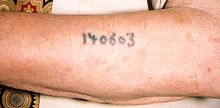User:Babadede/Tattoo in Auschwitz

The Auschwitz tattooing concerns the deportees that arrived at the concentration camp of Auschwitz from Spring 1942 and weren’t selected for the gas chambers and crematorium ovens. Auschwitz is the sole concentration camp using tattooed numbers.[1]. Other camps used number for deportees as well, but didn’t practice body tattooing.
History[edit]

From Spring 1942, the inmates, who were not selected for the gas chambers after their arrival, are tattooed on their left forearm.[2] [3].
The identification system in place in Auschwitz during the Second World War consisted of tattooing the registration number of the inmates.[4][5]. The tattoo process, at its beginning, was done via a seal, with continuously added numbers, pressed one centimetre under the skin with a “violent pressure”, then incisions obtained were filled with ink. Later, stamps made for “branding livestocks”, with steel pikes were used, they were provided by its manufacturer Aesculap, with a reading notice, and dipped into permanent ink, “into permanent ink before pressing them into the flesh”.
The romas, in the same camps, were tattooed a Z, for Zigeuner, roma in German.[6]. For a certain number of their children with too thin arms, they were tattooed on the thigh.[7].
- ^ "Tattoos and Numbers: The System of Identifying Prisoners at Auschwitz". encyclopedia.ushmm.org. Retrieved 2024-01-21.
- ^ "Le tatouage des déportés". enenvor.fr. Retrieved 2024-01-21.
- ^ "Un tatouage sur l'avant-bras gauche, abjecte signature du camp nazi d'Auschwitz". euronews (in French). 2015-01-26. Retrieved 2024-01-21.
- ^ Cipriani-Crauste, Marie (2008). Le tatouage dans tous ses états : A corps, désaccord (in French). Paris: Éditions L'Harmattan. pp. Page=216. ISBN ISBN 978-2-296-06258-0.
{{cite book}}: Check|isbn=value: invalid character (help) - ^ "Tattoos and Numbers: The System of Identifying Prisoners at Auschwitz". encyclopedia.ushmm.org. Retrieved 2024-01-21.
- ^ Kadar, Marlene (2005). Life writing series: Tracing the autobiographical. Vol. 27. Wilfrid Laurier Univ. Press. p. 233. ISBN 0-88920-476-4. OCLC 265754363.
{{cite book}}:|access-date=requires|url=(help); Unknown parameter|isbn2=ignored (help); Unknown parameter|pages totales=ignored (help) - ^ "Il a tatoué des milliers de Juifs à Auschwitz: qui était Lale Sokolov?". dossiers.lalibre.be. 2019-06-21. Retrieved 2023-08-08.
